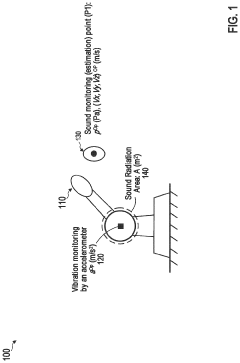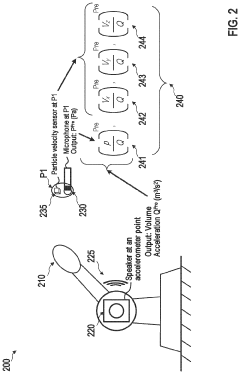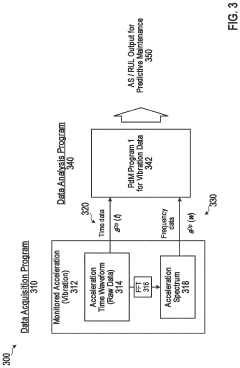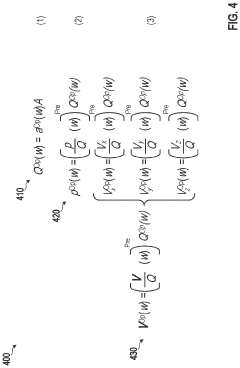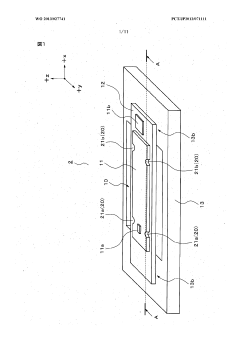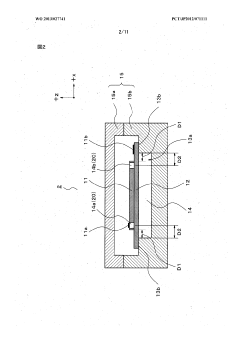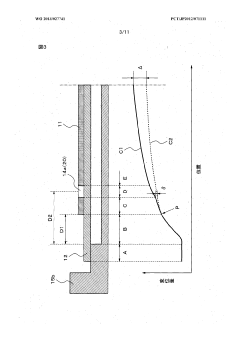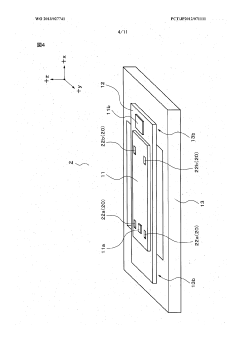How Piezoelectric Sensors Enhance Predictive Maintenance
JUL 17, 20259 MIN READ
Generate Your Research Report Instantly with AI Agent
Patsnap Eureka helps you evaluate technical feasibility & market potential.
Piezoelectric Sensors in Predictive Maintenance: Overview and Objectives
Piezoelectric sensors have emerged as a pivotal technology in the realm of predictive maintenance, revolutionizing the way industries monitor and maintain their equipment. These sensors, which convert mechanical stress into electrical signals, have a rich history dating back to the discovery of the piezoelectric effect by Pierre and Jacques Curie in 1880. Over the decades, the technology has evolved significantly, finding applications in various fields, including industrial maintenance.
The primary objective of integrating piezoelectric sensors into predictive maintenance strategies is to enhance the accuracy and efficiency of equipment monitoring. By detecting subtle changes in vibration, pressure, and other mechanical properties, these sensors provide real-time data that can be analyzed to predict potential failures before they occur. This proactive approach aims to minimize downtime, reduce maintenance costs, and extend the lifespan of industrial machinery.
As the industrial landscape continues to embrace Industry 4.0 principles, the role of piezoelectric sensors in predictive maintenance is becoming increasingly crucial. The technology aligns perfectly with the trend towards smart factories and the Internet of Things (IoT), where continuous monitoring and data-driven decision-making are paramount. The integration of piezoelectric sensors with advanced analytics and machine learning algorithms is opening new frontiers in predictive maintenance capabilities.
The evolution of piezoelectric sensor technology has been marked by significant improvements in sensitivity, durability, and miniaturization. Modern sensors can detect minute vibrations and stress levels that were previously undetectable, allowing for earlier and more accurate predictions of equipment failure. Additionally, advancements in materials science have led to the development of sensors that can withstand harsh industrial environments, expanding their applicability across various sectors.
Looking ahead, the trajectory of piezoelectric sensor technology in predictive maintenance is poised for further innovation. Research is ongoing to develop self-powered sensors that can harvest energy from their environment, potentially eliminating the need for external power sources. Moreover, the integration of wireless communication capabilities is expected to simplify installation and expand the reach of sensor networks within industrial settings.
As industries continue to seek ways to optimize their operations and reduce costs, the adoption of piezoelectric sensors for predictive maintenance is likely to accelerate. The technology promises to transform maintenance practices from reactive to proactive, ultimately leading to more efficient, reliable, and cost-effective industrial operations. The ongoing development and refinement of piezoelectric sensor technology will play a crucial role in shaping the future of predictive maintenance strategies across various industries.
The primary objective of integrating piezoelectric sensors into predictive maintenance strategies is to enhance the accuracy and efficiency of equipment monitoring. By detecting subtle changes in vibration, pressure, and other mechanical properties, these sensors provide real-time data that can be analyzed to predict potential failures before they occur. This proactive approach aims to minimize downtime, reduce maintenance costs, and extend the lifespan of industrial machinery.
As the industrial landscape continues to embrace Industry 4.0 principles, the role of piezoelectric sensors in predictive maintenance is becoming increasingly crucial. The technology aligns perfectly with the trend towards smart factories and the Internet of Things (IoT), where continuous monitoring and data-driven decision-making are paramount. The integration of piezoelectric sensors with advanced analytics and machine learning algorithms is opening new frontiers in predictive maintenance capabilities.
The evolution of piezoelectric sensor technology has been marked by significant improvements in sensitivity, durability, and miniaturization. Modern sensors can detect minute vibrations and stress levels that were previously undetectable, allowing for earlier and more accurate predictions of equipment failure. Additionally, advancements in materials science have led to the development of sensors that can withstand harsh industrial environments, expanding their applicability across various sectors.
Looking ahead, the trajectory of piezoelectric sensor technology in predictive maintenance is poised for further innovation. Research is ongoing to develop self-powered sensors that can harvest energy from their environment, potentially eliminating the need for external power sources. Moreover, the integration of wireless communication capabilities is expected to simplify installation and expand the reach of sensor networks within industrial settings.
As industries continue to seek ways to optimize their operations and reduce costs, the adoption of piezoelectric sensors for predictive maintenance is likely to accelerate. The technology promises to transform maintenance practices from reactive to proactive, ultimately leading to more efficient, reliable, and cost-effective industrial operations. The ongoing development and refinement of piezoelectric sensor technology will play a crucial role in shaping the future of predictive maintenance strategies across various industries.
Market Demand for Advanced Predictive Maintenance Solutions
The market demand for advanced predictive maintenance solutions has been experiencing significant growth in recent years, driven by the increasing need for operational efficiency, cost reduction, and equipment reliability across various industries. As businesses strive to minimize downtime and optimize their maintenance strategies, the integration of piezoelectric sensors in predictive maintenance systems has emerged as a promising solution.
Industries such as manufacturing, aerospace, automotive, and energy have shown a particularly strong interest in adopting advanced predictive maintenance technologies. These sectors rely heavily on complex machinery and equipment, where unexpected failures can result in substantial financial losses and safety risks. The ability of piezoelectric sensors to detect early signs of wear, vibration anomalies, and other potential issues has made them invaluable in these high-stakes environments.
The global predictive maintenance market is projected to expand rapidly, with some estimates suggesting a compound annual growth rate (CAGR) of over 25% in the coming years. This growth is largely attributed to the increasing adoption of Industrial Internet of Things (IIoT) technologies and the push towards Industry 4.0 practices. Piezoelectric sensors, with their ability to provide real-time, high-precision data on equipment health, are well-positioned to capitalize on this trend.
One of the key drivers of market demand is the potential for significant cost savings through improved maintenance practices. By accurately predicting when maintenance is required, companies can avoid unnecessary downtime and reduce the frequency of unplanned repairs. This proactive approach not only extends the lifespan of equipment but also optimizes resource allocation and improves overall operational efficiency.
Furthermore, the growing emphasis on sustainability and energy efficiency has created additional demand for advanced predictive maintenance solutions. Piezoelectric sensors can help identify inefficiencies in equipment operation, allowing businesses to reduce energy consumption and minimize their environmental footprint. This aligns with the increasing regulatory pressure and corporate sustainability goals across industries.
The market is also seeing a shift towards more sophisticated, integrated predictive maintenance systems that combine multiple sensor types, including piezoelectric sensors, with advanced analytics and machine learning algorithms. This trend is driven by the need for more comprehensive and accurate predictions, as well as the desire to extract maximum value from maintenance data.
As the technology continues to evolve, there is a growing demand for piezoelectric sensors with enhanced capabilities, such as improved sensitivity, wider frequency ranges, and better resistance to harsh environmental conditions. This presents opportunities for innovation and product development in the sensor market, further fueling the growth of advanced predictive maintenance solutions.
Industries such as manufacturing, aerospace, automotive, and energy have shown a particularly strong interest in adopting advanced predictive maintenance technologies. These sectors rely heavily on complex machinery and equipment, where unexpected failures can result in substantial financial losses and safety risks. The ability of piezoelectric sensors to detect early signs of wear, vibration anomalies, and other potential issues has made them invaluable in these high-stakes environments.
The global predictive maintenance market is projected to expand rapidly, with some estimates suggesting a compound annual growth rate (CAGR) of over 25% in the coming years. This growth is largely attributed to the increasing adoption of Industrial Internet of Things (IIoT) technologies and the push towards Industry 4.0 practices. Piezoelectric sensors, with their ability to provide real-time, high-precision data on equipment health, are well-positioned to capitalize on this trend.
One of the key drivers of market demand is the potential for significant cost savings through improved maintenance practices. By accurately predicting when maintenance is required, companies can avoid unnecessary downtime and reduce the frequency of unplanned repairs. This proactive approach not only extends the lifespan of equipment but also optimizes resource allocation and improves overall operational efficiency.
Furthermore, the growing emphasis on sustainability and energy efficiency has created additional demand for advanced predictive maintenance solutions. Piezoelectric sensors can help identify inefficiencies in equipment operation, allowing businesses to reduce energy consumption and minimize their environmental footprint. This aligns with the increasing regulatory pressure and corporate sustainability goals across industries.
The market is also seeing a shift towards more sophisticated, integrated predictive maintenance systems that combine multiple sensor types, including piezoelectric sensors, with advanced analytics and machine learning algorithms. This trend is driven by the need for more comprehensive and accurate predictions, as well as the desire to extract maximum value from maintenance data.
As the technology continues to evolve, there is a growing demand for piezoelectric sensors with enhanced capabilities, such as improved sensitivity, wider frequency ranges, and better resistance to harsh environmental conditions. This presents opportunities for innovation and product development in the sensor market, further fueling the growth of advanced predictive maintenance solutions.
Current State and Challenges of Piezoelectric Sensor Technology
Piezoelectric sensor technology has made significant strides in recent years, particularly in the field of predictive maintenance. The current state of this technology is characterized by its ability to detect and measure mechanical stress, vibration, and pressure with high sensitivity and precision. These sensors are widely deployed across various industries, including manufacturing, aerospace, automotive, and energy sectors, where they play a crucial role in monitoring equipment health and performance.
One of the primary advantages of piezoelectric sensors in predictive maintenance is their ability to operate in harsh environments and at high temperatures, making them ideal for use in industrial settings. They offer real-time data collection and analysis, enabling early detection of potential equipment failures and reducing downtime. The technology has evolved to include wireless and self-powered sensors, further enhancing their versatility and ease of implementation.
Despite these advancements, piezoelectric sensor technology faces several challenges. One significant hurdle is the need for improved signal processing and data interpretation algorithms. As sensors become more sensitive and collect larger volumes of data, there is a growing demand for more sophisticated analytics to extract meaningful insights and reduce false positives in fault detection.
Another challenge lies in the integration of piezoelectric sensors with existing industrial systems and IoT platforms. Seamless connectivity and interoperability remain areas of ongoing development, as many legacy systems were not designed with advanced sensor networks in mind. This integration challenge often requires significant investment in infrastructure upgrades and software development.
The durability and longevity of piezoelectric sensors in extreme industrial conditions also present ongoing challenges. While these sensors are known for their robustness, prolonged exposure to harsh chemicals, extreme temperatures, and constant vibrations can degrade their performance over time. Research is ongoing to develop more resilient materials and protective coatings to extend sensor lifespan and maintain accuracy.
Miniaturization and energy efficiency are additional areas of focus in the current development of piezoelectric sensor technology. As the demand for more compact and energy-efficient sensors grows, researchers are exploring new materials and designs to reduce power consumption while maintaining or improving sensor performance. This is particularly crucial for applications in remote or hard-to-reach locations where power sources may be limited.
Lastly, the cost of implementing comprehensive piezoelectric sensor networks for predictive maintenance remains a barrier for some organizations, particularly small and medium-sized enterprises. While the long-term benefits of predictive maintenance are clear, the initial investment in sensors, data acquisition systems, and analytics platforms can be substantial. Efforts are underway to develop more cost-effective solutions and demonstrate clearer ROI models to encourage wider adoption across industries.
One of the primary advantages of piezoelectric sensors in predictive maintenance is their ability to operate in harsh environments and at high temperatures, making them ideal for use in industrial settings. They offer real-time data collection and analysis, enabling early detection of potential equipment failures and reducing downtime. The technology has evolved to include wireless and self-powered sensors, further enhancing their versatility and ease of implementation.
Despite these advancements, piezoelectric sensor technology faces several challenges. One significant hurdle is the need for improved signal processing and data interpretation algorithms. As sensors become more sensitive and collect larger volumes of data, there is a growing demand for more sophisticated analytics to extract meaningful insights and reduce false positives in fault detection.
Another challenge lies in the integration of piezoelectric sensors with existing industrial systems and IoT platforms. Seamless connectivity and interoperability remain areas of ongoing development, as many legacy systems were not designed with advanced sensor networks in mind. This integration challenge often requires significant investment in infrastructure upgrades and software development.
The durability and longevity of piezoelectric sensors in extreme industrial conditions also present ongoing challenges. While these sensors are known for their robustness, prolonged exposure to harsh chemicals, extreme temperatures, and constant vibrations can degrade their performance over time. Research is ongoing to develop more resilient materials and protective coatings to extend sensor lifespan and maintain accuracy.
Miniaturization and energy efficiency are additional areas of focus in the current development of piezoelectric sensor technology. As the demand for more compact and energy-efficient sensors grows, researchers are exploring new materials and designs to reduce power consumption while maintaining or improving sensor performance. This is particularly crucial for applications in remote or hard-to-reach locations where power sources may be limited.
Lastly, the cost of implementing comprehensive piezoelectric sensor networks for predictive maintenance remains a barrier for some organizations, particularly small and medium-sized enterprises. While the long-term benefits of predictive maintenance are clear, the initial investment in sensors, data acquisition systems, and analytics platforms can be substantial. Efforts are underway to develop more cost-effective solutions and demonstrate clearer ROI models to encourage wider adoption across industries.
Existing Piezoelectric Sensor-based Maintenance Solutions
01 Piezoelectric sensor integration for predictive maintenance
Piezoelectric sensors are integrated into various systems to monitor vibrations, stress, and other physical parameters. These sensors provide real-time data that can be analyzed to predict potential failures or maintenance needs, enabling proactive maintenance strategies and reducing downtime.- Integration of piezoelectric sensors in predictive maintenance systems: Piezoelectric sensors are incorporated into predictive maintenance systems to monitor equipment vibrations and detect potential failures. These sensors convert mechanical stress into electrical signals, allowing for real-time analysis of machine health and performance. By continuously monitoring vibration patterns, the system can identify anomalies and predict when maintenance is required, reducing downtime and improving overall equipment efficiency.
- Data analysis and machine learning for predictive maintenance: Advanced data analysis techniques and machine learning algorithms are employed to process the data collected from piezoelectric sensors. These methods help in identifying patterns, trends, and anomalies in equipment behavior. By analyzing historical data and real-time sensor inputs, the system can predict potential failures, optimize maintenance schedules, and provide actionable insights for preventive measures.
- Wireless sensor networks for remote monitoring: Wireless sensor networks are implemented to facilitate remote monitoring of equipment using piezoelectric sensors. These networks enable the transmission of sensor data to central monitoring stations or cloud-based platforms, allowing for real-time analysis and decision-making. This approach enhances the flexibility and scalability of predictive maintenance systems, particularly in large industrial settings or geographically dispersed assets.
- Integration with Industrial Internet of Things (IIoT): Piezoelectric sensor-based predictive maintenance systems are integrated with Industrial Internet of Things (IIoT) platforms. This integration allows for seamless connectivity between various industrial assets, sensors, and data analytics systems. The IIoT framework enables comprehensive monitoring, data collection, and analysis across multiple machines and production lines, leading to improved overall equipment effectiveness and predictive maintenance capabilities.
- Energy harvesting for self-powered sensors: Energy harvesting techniques are developed to create self-powered piezoelectric sensors for predictive maintenance. These sensors utilize the vibrations they are monitoring to generate their own power, eliminating the need for external power sources or frequent battery replacements. This approach enhances the longevity and reliability of the sensor network, making it particularly suitable for hard-to-reach or hazardous environments where regular maintenance is challenging.
02 Data analysis and machine learning for predictive maintenance
Advanced data analysis techniques and machine learning algorithms are applied to the data collected from piezoelectric sensors. These methods help in identifying patterns, anomalies, and trends that indicate potential equipment failures or maintenance requirements, improving the accuracy of predictive maintenance systems.Expand Specific Solutions03 Wireless sensor networks for remote monitoring
Wireless sensor networks incorporating piezoelectric sensors are developed for remote monitoring of equipment and structures. These networks enable real-time data collection and transmission, facilitating continuous monitoring and predictive maintenance in hard-to-reach or hazardous environments.Expand Specific Solutions04 Energy harvesting for self-powered sensors
Piezoelectric sensors are designed to harvest energy from ambient vibrations, enabling self-powered operation. This feature allows for long-term deployment of sensors in remote or inaccessible locations without the need for battery replacement, enhancing the reliability and cost-effectiveness of predictive maintenance systems.Expand Specific Solutions05 Integration with IoT and cloud-based platforms
Piezoelectric sensor systems are integrated with Internet of Things (IoT) and cloud-based platforms to create comprehensive predictive maintenance solutions. This integration allows for centralized data storage, advanced analytics, and remote access to maintenance insights, enabling more efficient and effective maintenance strategies across multiple assets or locations.Expand Specific Solutions
Key Players in Piezoelectric Sensor and Predictive Maintenance Industry
The piezoelectric sensor market for predictive maintenance is in a growth phase, driven by increasing industrial automation and demand for efficient maintenance solutions. The market size is expanding rapidly, with projections indicating significant growth in the coming years. Technologically, piezoelectric sensors are maturing, with ongoing advancements in sensitivity, durability, and integration capabilities. Key players like Robert Bosch, Murata Manufacturing, and Siemens are leading innovation, while specialized firms such as Piezocryst Advanced Sensorics and Ionix Advanced Technologies are pushing the boundaries of piezoelectric technology. The competitive landscape is diverse, with both established industrial giants and niche technology providers vying for market share in this promising field.
Murata Manufacturing Co. Ltd.
Technical Solution: Murata has developed advanced piezoelectric sensors for predictive maintenance applications. Their sensors utilize high-performance piezoelectric ceramics to detect minute vibrations and structural changes in machinery. The company's MEMS-based accelerometers offer high sensitivity and wide frequency response, enabling early detection of equipment anomalies[1]. Murata's sensors are designed for harsh industrial environments, with robust packaging that can withstand extreme temperatures and contaminants. They have also integrated wireless connectivity options, allowing for real-time data transmission to centralized monitoring systems[2]. This enables continuous equipment health monitoring and facilitates timely maintenance interventions.
Strengths: High sensitivity, wide frequency range, robust design for industrial use, wireless connectivity. Weaknesses: May require specialized knowledge for optimal implementation, potentially higher cost compared to simpler sensors.
Siemens Corp.
Technical Solution: Siemens has developed a comprehensive predictive maintenance solution that leverages piezoelectric sensors as part of their Industrial IoT ecosystem. Their system combines high-precision piezoelectric sensors with advanced analytics and machine learning algorithms to provide real-time equipment health monitoring. Siemens' piezoelectric sensors are integrated into their MindSphere IoT platform, allowing for seamless data collection, analysis, and visualization[3]. The company has also developed specialized sensor arrays that can be retrofitted to existing machinery, enabling predictive maintenance capabilities for legacy equipment. Siemens' solution includes adaptive algorithms that learn from historical data to improve fault detection accuracy over time, reducing false alarms and optimizing maintenance schedules[4].
Strengths: Comprehensive end-to-end solution, integration with IoT platform, adaptive learning capabilities. Weaknesses: Potential vendor lock-in, may require significant investment for full implementation.
Core Innovations in Piezoelectric Sensor Technology
Robust predictive maintenance method for machinery using measured vibration data and estimated sound data
PatentPendingUS20240264045A1
Innovation
- The method involves estimating sound data from measured vibration data using a pre-measured acoustic transfer function, which is calculated during quiet times, allowing for reduced microphone usage and improved noise reduction by leveraging the lower noise levels in vibration data.
Piezoelectric vibration sensor
PatentWO2013027741A1
Innovation
- A piezoelectric vibration sensor employing a double-supported beam structure with a displacement amount enlarging portion, such as notches or through holes, is used to expand displacement in the thickness direction of the piezoelectric structure, reducing stress concentration and improving detection sensitivity while maintaining sensor longevity.
Industrial IoT Integration with Piezoelectric Sensors
The integration of piezoelectric sensors with Industrial Internet of Things (IIoT) systems represents a significant advancement in predictive maintenance strategies. This synergy enables real-time monitoring of equipment health, enhancing the accuracy and efficiency of maintenance operations across various industrial sectors.
Piezoelectric sensors, known for their ability to convert mechanical stress into electrical signals, serve as the foundation for this integration. When incorporated into IIoT networks, these sensors provide continuous data streams on vibration, pressure, and other critical parameters of industrial machinery. This constant flow of information allows for the early detection of potential equipment failures, reducing downtime and maintenance costs.
The IIoT infrastructure facilitates the collection, transmission, and analysis of data from multiple piezoelectric sensors distributed throughout a manufacturing facility. Cloud-based platforms and edge computing systems process this data, applying advanced analytics and machine learning algorithms to identify patterns and anomalies that may indicate impending equipment issues.
One of the key advantages of this integration is the ability to perform condition-based maintenance rather than relying on scheduled maintenance intervals. By analyzing sensor data in real-time, maintenance teams can prioritize their efforts, focusing on equipment that shows signs of deterioration or unusual behavior. This approach optimizes resource allocation and extends the lifespan of industrial assets.
Furthermore, the combination of piezoelectric sensors and IIoT enables the development of digital twins – virtual representations of physical equipment. These digital models, continuously updated with sensor data, allow for predictive simulations and what-if analyses, enhancing decision-making processes in maintenance planning and equipment optimization.
The scalability of IIoT systems also means that piezoelectric sensor networks can be easily expanded or reconfigured to adapt to changing industrial environments. This flexibility ensures that predictive maintenance strategies can evolve alongside technological advancements and shifting operational requirements.
As industries continue to embrace digital transformation, the integration of piezoelectric sensors with IIoT is poised to become a cornerstone of smart manufacturing and Industry 4.0 initiatives. This technological convergence not only improves operational efficiency but also contributes to enhanced safety, reduced environmental impact, and increased overall equipment effectiveness in industrial settings.
Piezoelectric sensors, known for their ability to convert mechanical stress into electrical signals, serve as the foundation for this integration. When incorporated into IIoT networks, these sensors provide continuous data streams on vibration, pressure, and other critical parameters of industrial machinery. This constant flow of information allows for the early detection of potential equipment failures, reducing downtime and maintenance costs.
The IIoT infrastructure facilitates the collection, transmission, and analysis of data from multiple piezoelectric sensors distributed throughout a manufacturing facility. Cloud-based platforms and edge computing systems process this data, applying advanced analytics and machine learning algorithms to identify patterns and anomalies that may indicate impending equipment issues.
One of the key advantages of this integration is the ability to perform condition-based maintenance rather than relying on scheduled maintenance intervals. By analyzing sensor data in real-time, maintenance teams can prioritize their efforts, focusing on equipment that shows signs of deterioration or unusual behavior. This approach optimizes resource allocation and extends the lifespan of industrial assets.
Furthermore, the combination of piezoelectric sensors and IIoT enables the development of digital twins – virtual representations of physical equipment. These digital models, continuously updated with sensor data, allow for predictive simulations and what-if analyses, enhancing decision-making processes in maintenance planning and equipment optimization.
The scalability of IIoT systems also means that piezoelectric sensor networks can be easily expanded or reconfigured to adapt to changing industrial environments. This flexibility ensures that predictive maintenance strategies can evolve alongside technological advancements and shifting operational requirements.
As industries continue to embrace digital transformation, the integration of piezoelectric sensors with IIoT is poised to become a cornerstone of smart manufacturing and Industry 4.0 initiatives. This technological convergence not only improves operational efficiency but also contributes to enhanced safety, reduced environmental impact, and increased overall equipment effectiveness in industrial settings.
Cost-Benefit Analysis of Piezoelectric Sensor Implementation
Implementing piezoelectric sensors for predictive maintenance offers significant cost-benefit advantages for industrial operations. The initial investment in sensor hardware and installation is typically offset by substantial long-term savings in maintenance costs and increased equipment uptime.
One of the primary benefits is the reduction in unplanned downtime. By detecting early signs of equipment wear or malfunction, piezoelectric sensors enable maintenance teams to address issues before they lead to catastrophic failures. This proactive approach can result in savings of up to 30-50% on maintenance costs compared to reactive maintenance strategies.
The improved accuracy of fault detection also leads to more efficient use of maintenance resources. Instead of relying on scheduled maintenance, which may result in unnecessary interventions or missed issues, predictive maintenance allows for targeted, just-in-time repairs. This optimization can reduce overall maintenance labor costs by 20-30% and extend equipment lifespan by 20-40%.
Energy savings represent another significant benefit. Piezoelectric sensors can detect inefficiencies in equipment operation, such as increased vibration or temperature anomalies, which often indicate energy waste. By addressing these issues promptly, companies can reduce energy consumption by 5-15%, leading to substantial cost savings in energy-intensive industries.
The implementation of piezoelectric sensors also contributes to improved product quality and reduced scrap rates. By ensuring equipment operates within optimal parameters, manufacturers can minimize defects and waste, potentially saving 10-20% on material costs.
While the upfront costs of implementing a piezoelectric sensor-based predictive maintenance system can be significant, ranging from $50,000 to $500,000 depending on the scale of operations, the return on investment is typically realized within 12-24 months. Over a five-year period, companies can expect to see a 10:1 return on their initial investment.
It's important to note that the cost-benefit ratio can vary depending on factors such as industry type, equipment criticality, and existing maintenance practices. However, across various sectors, the implementation of piezoelectric sensors for predictive maintenance consistently demonstrates a positive return on investment, making it a valuable strategy for enhancing operational efficiency and reducing overall maintenance costs.
One of the primary benefits is the reduction in unplanned downtime. By detecting early signs of equipment wear or malfunction, piezoelectric sensors enable maintenance teams to address issues before they lead to catastrophic failures. This proactive approach can result in savings of up to 30-50% on maintenance costs compared to reactive maintenance strategies.
The improved accuracy of fault detection also leads to more efficient use of maintenance resources. Instead of relying on scheduled maintenance, which may result in unnecessary interventions or missed issues, predictive maintenance allows for targeted, just-in-time repairs. This optimization can reduce overall maintenance labor costs by 20-30% and extend equipment lifespan by 20-40%.
Energy savings represent another significant benefit. Piezoelectric sensors can detect inefficiencies in equipment operation, such as increased vibration or temperature anomalies, which often indicate energy waste. By addressing these issues promptly, companies can reduce energy consumption by 5-15%, leading to substantial cost savings in energy-intensive industries.
The implementation of piezoelectric sensors also contributes to improved product quality and reduced scrap rates. By ensuring equipment operates within optimal parameters, manufacturers can minimize defects and waste, potentially saving 10-20% on material costs.
While the upfront costs of implementing a piezoelectric sensor-based predictive maintenance system can be significant, ranging from $50,000 to $500,000 depending on the scale of operations, the return on investment is typically realized within 12-24 months. Over a five-year period, companies can expect to see a 10:1 return on their initial investment.
It's important to note that the cost-benefit ratio can vary depending on factors such as industry type, equipment criticality, and existing maintenance practices. However, across various sectors, the implementation of piezoelectric sensors for predictive maintenance consistently demonstrates a positive return on investment, making it a valuable strategy for enhancing operational efficiency and reducing overall maintenance costs.
Unlock deeper insights with Patsnap Eureka Quick Research — get a full tech report to explore trends and direct your research. Try now!
Generate Your Research Report Instantly with AI Agent
Supercharge your innovation with Patsnap Eureka AI Agent Platform!
